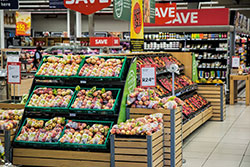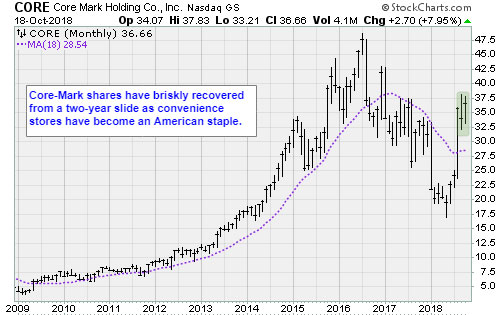Convenience store distributor turns fast food into a quick buck
Big is the only story today. Scale is everything. Some companies learned this early. Investors should seek those businesses.
Core-Mark Holding Co. (CORE) is not your typical growth business. It operates one of the largest convenience store supply networks in North America.
Don’t chuckle. Filling shelves at 7-Eleven is a great business.
The company was born in 1888 in the hills of San Francisco, when the Glasser brothers hung a sign outside their store. The business began as a tobacco distributor, wholesaling a variety of brands to local shops, hotels and watering holes.
In the fledgling days of the Wild West, tobacco was a hot commodity. Business was good. And it has gotten a whole lot better …
Through the next 100 years, the product line diversified and the client list expanded. But Glasser Bros. remained a family business until David Gillespie bought it in 1974. A decade later, he listed shares on the Toronto Stock Exchange.
There have been investments by private equity firms, buyouts and troubles along the way. In 2002 Core-Mark was folded into Fleming Cos., a bustling conglomerate. Two years later the parent company went bankrupt, dragging Core-Mark along.
Since 2005, Core-Mark has been a standalone business. Managers refocused. They concentrated on convenience store chains. In addition to supplying branded products, they developed a program to work closely with clients, making their stores more efficient, profitable and more desirous to core customers.
Today, the Core Essentials program encourages stores to build customer loyalty by making locations a destination for in-store food sales and fresh coffee. Company research shows snack food and coffee sales make up 22.5% of gross sales and 33.9% of profits.
These increasingly health-focused, grab-and-go items are delivered regularly and can be prepared on site. The goal is to make customers feel as though they can always get a convenient, quick bite to eat before heading to the soccer practice or dance rehearsal. Stores benefit from retention, and the chance to tempt shoppers with high-margin, last-minute impulse buys on the way to the register.
Scott McPherson, chief executive officer, applies the same analytical thinking to running company operations.

Under his watch, Core-Mark has been focused on relentlessly growing scale. Getting big fast is a huge competitive advantage in a niche that is extremely fragmented. Smaller mom-and-pop distributors can’t possibly compete on price and operational excellence.
And McPherson sees the opportunity to grow both organically and through strategic acquisitions.
The company signed a wholesale distribution deal with Walmart in 2016. Core-Mark now supplies 530 Walmart Neighborhood Market stores with candy, tobacco and snack foods.
In 2017, Farner-Bocken, an Iowa-based food distributor, was folded into Core-Mark. In addition to a 430,000-square-foot, state-of-the-art warehouse and 2016 sales of $1.4 billion, Farner brought geographic synergy. At $190 million, it was a steal.
Following the release of second-quarter financial results Aug. 7, McPherson told analysts Core-Mark was targeting 8%-10% earnings growth during the next several years as it drives scale. He expects faster and more profitable growth … more progress in category management like fresh food service … and improved operational leverage.
Software-led initiatives are underway to increase driver efficiency, sales and warehouse organization.
All of these core advantages make Core-Mark a more formidable competitor …
According to the National Association of Convenience Stores, an industry lobbying group, convenience stores are among the fastest-growing segments of the $5.75 trillion retail food and service market. The industry experienced its 15th-consecutive year of sales growth. In-store sales rose 1.7% to $237 billion. Core-Mark itself logged $15.7 billion in sales during 2017, up 8% year-over-year.
The company is at the forefront of all of the NACS leading trends. Prepared foods — especially healthy snacks rich in protein and energy — were the top trend for the third-consecutive year.
Core-Mark started this trend, and it is the likely beneficiary as it grows larger and takes more market share.
The business is lightyears away from the storefront the Glasser brothers put up in the heart of San Francisco, but the focus is the same. The company is still trying to help customers run their stores more profitably. It is still the vision leader.
Core-Mark shares trade at 25x forward earnings, while paying a 1.1% dividend. With a market capitalization of only $1.7 billion, it is not expensive by any metric.
It is a big player with aspirations to get even bigger. Scale is everything in retail. And Core-Mark is in the fastest-growing part of the trade. Buy the stock on weakness.
Best wishes,
Jon D. Markman




